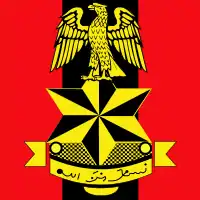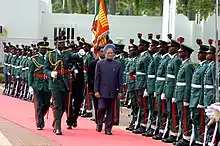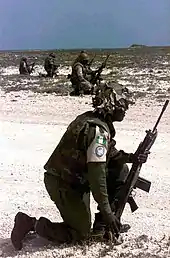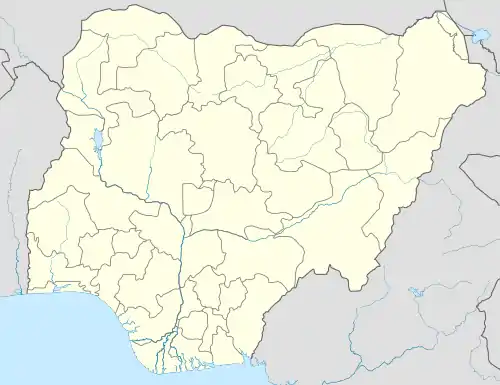Nigerian Army
The Nigerian Army (NA) is the largest component of the Nigerian Armed Forces, and is responsible for land warfare operations. It is governed by the Nigerian Army Council (NAC).[3]
| Nigerian Army | |
|---|---|
 Emblem of the Nigerian Army | |
| Founded | 1960 |
| Country | |
| Type | Army |
| Role | Land warfare |
| Size | 100,000 (2020)[1] |
| Part of | Nigerian Armed Forces |
| Headquarters | Abuja |
| Motto(s) | "Victory is from God alone!" |
| Anniversaries | Nigerian Army Day (6 July) |
| Engagements | Congo Crisis Nigerian Civil War First Liberian Civil War Sierra Leone Civil War Nigeria-Cameroon border conflict Conflict in the Niger Delta Boko Haram insurgency Northern Mali War Invasion of the Gambia Orlu Crisis |
| Website | http://army.mil.ng/ |
| Commanders | |
| Commander-in-Chief | President Muhammadu Buhari |
| Chief of Army Staff | Major General Ibrahim Attahiru[2] |
| Notable commanders |
|
| Insignia | |
| Flag |  |
History
The original elements of the Royal West African Frontier Force (RWAFF) in Nigeria were formed in 1900. During the Second World War, British-trained Nigerian troops saw action with the 1st (West Africa) Infantry Brigade, the 81st and the 82nd (West Africa) Divisions which fought in the East African Campaign (World War II) and in the Far East.
The roots of the ethnic cleavages which started to rip through the army after independence had some of their origins in colonial recruiting practices, with line infantry and the artillery being raised from the North, but during the expansion of the force during the Second World War a large proportion of more educated southerners being brought in to take up posts that required more technical training. Like in Ghana, there was significant pressure to "Nigerianize" the armed forces, with, for example, two officers being promoted to Brigadier as a concession to public opinion on the occasion of the last British commander arriving in Lagos. From a force of 8,000 in five infantry battalions and supporting units,[4] strength rose to around 120,000 in three divisions by the end of the Nigerian Civil War in 1970.[5] In terms of doctrine, the task of the Federal Nigerian army did not fundamentally change: its task remained to close with and defeat an organized enemy.
The rapid expansion saw a severe decline in troop quality.[6] The Nigerian expansion process led to an extreme shortage of commissioned officers, with newly created lieutenant-colonels commanding brigades, and platoons and companies often commanded by sergeants and warrant officers. This resulted in tentative command-and-control and in rudimentary staff work.[7] One result of the weak direction was that the Federals' three divisions fought independently, and competed for men and material. Writing in a 1984 study, Major Michael Stafford of the US Marine Corps noted that "Inexperienced, poorly trained and ineptly led soldiers manifested their lack of professionalism and indiscipline by massacres of innocent civilians and a failure to effectively execute infantry tactics."[8] Among the results was the 1967 Asaba massacre.
The influence of individual personalities is generally greater in the armies of developing states, as they tend to have weaker institutional frameworks. Key personalities involved in Nigeria included then-Colonel Olusegun Obasanjo. Obasanjo is particularly important due to his efforts to reorganize his command, 3 Division, during the civil war to improve its logistics and administration. The reorganization he instituted made the Division capable of carrying out the offensive that ended the civil war.
The US intelligence community concluded in November 1970 that "..The Nigerian Civil War ended with relatively little rancor. The Igbos are accepted as fellow citizens in many parts of Nigeria, but not in some areas of former Biafra where they were once dominant. Igboland is an overpopulated, economically depressed area where massive unemployment is likely to continue for many years.[9]
The US analysts said that "..Nigeria is still very much a tribal society..." where local and tribal alliances count more than "national attachment. General Yakubu Gowon, head of the Federal Military Government (FMG) is the accepted national leader and his popularity has grown since the end of the war. The FMG is neither very efficient nor dynamic, but the recent announcement that it intends to retain power for six more years has generated little opposition so far. The Nigerian Army, vastly expanded during the war, is both the main support to the FMG and the chief threat to it. The troops are poorly trained and disciplined and some of the officers are turning to conspiracies and plotting. We think Gowon will have great difficulty in staying in office through the period which he said is necessary before the turnover of power to civilians. His sudden removal would dim the prospects for Nigerian stability."
The Nigerian Army fought the Civil War significantly under-resourced; Obasanjo's memoirs chronicle the lack of any stocks of extra equipment for mobilisation and the "haphazard and unreliable system of procurement and provisioning" which lasted for the entire period of the war.[10] Arms embargoes imposed by several Western countries made the situation more difficult.
At the end of the Civil War, the three divisions of the Army were reorganised into four divisions, with each controlling territories running from North to South in order to deemphasise the former regional structure. Each division thus had access to the sea thereby making triservice cooperation and logistic support easier. This deployment formula was later abandoned in favour of the present assignment of sectors to the divisions. Thus 1 Division with HQ at Kaduna is allocated the North West sector; 2 Division with HQ at Ibadan South West sector, 3 Division with HQ at Jos North East sector and 82 Division with HQ at Enugu South East sector.[11]
Its formations include the 1 Division, headquartered in Kaduna in the north-west, and 2 Division (HQ Ibadan in the South-West, which includes 32 Artillery Brigade at Abeokuta).[12] 2nd Division also possibly includes 4 Brigade at Benin City, with 19 Battalion at Okitipupa and 195 Battalion at Agenebode. 52 Signal Regiment may be the divisional signals unit. 3 Division's headquarters is at Rukuba Cantonment, Jos, in the North-East, and includes 21 Armoured Brigade Maiduguri, 23 Brigade Yola, and 33 Artillery Brigades.[13] 81st Division (Amphibious) HQ in Lagos, which includes the 9 Brigade, based at Ikeja Cantonment in northern Lagos, 82nd Division (Airborne and Amphibious) HQ in Enugu in the South-East, which includes the 2 Brigade at Port Harcourt, 13 Brigade at Calabar and the 34th Artillery Brigade at Obinze/Owerri. The Composite Division at Enugu was formed in 1964 as 4 Division, in 1975 became Lagos Garrison Organization; in 1981 became 4 Composite Division; became a Composite Division in May 2002.[14] 3rd Armoured Division was responsible in 1983 for the security of areas bordering Chad.[15]
Lagos and Abuja have garrison commands, with the Lagos garrison as large as a division. 81st Division was previously the youngest division, formed on 26 May 2002 when the Lagos Garrison Command (as it then was) was upgraded to divisional status. The Division, therefore, inherited the security roles hitherto performed by the defunct Lagos Garrison Command.[16] However a later undated article in a Nigerian online newspaper says the 81st Division was later again renamed the Lagos Garrison Command. In the 1980s, the Army's brigades included the 7th Infantry Brigade in Sokoto. There are also Divisional Artillery Brigades, among which are the 32 and 34 Artillery Brigades,[17] ordnance corps units as well as Combat Engineer Regiments, and many other service support units spread across the country.
The 7th Division (also known as JTF-RO) was established in August 2013 for the war against Boko Haram. The creation of the new division brought to six the number of divisions. The 7th division is headquartered in Maiduguri.[18] The division includes a combat motorcycle unit as part of its 25th Task Force Brigade.[19] The purpose of this unit is stated as securing roads in Yobe and serving as a force multiplier in combat operations.[19] Training and Doctrine Command formed in 1981, and is located at Minna. It supervises the Army's schools, including the Depot. The Army sponsors the Nigerian Military School at Zaria.
Structure
The Nigerian Army is governed by the Nigerian Army Council (NAC). The Nigerian Army is functionally organized into combat arms, which are infantry and armored; the combat support arms, which are artillery, engineers, and signals; the combat support services comprise the Nigerian Army Medical Corps,[20] supply and transport, ordinance and finance. Others include the military police, intelligence, physical training, chaplains, public relations and band.[21] Training and Doctrine Command (TRADOC) located in Minna is responsible for doctrinal, training and combat development, and supervises training centers. There are 17 Corps Training Schools and the Nigerian Army College of Logistics (NACOL).[21][22]
The Nigerian Army said its newly created the 6th Division in Port Harcourt was established to organize and improve its internal security operations in four states of the Niger Delta. The Division will cover the Army's 2 Brigade Akwa Ibom; 16 Brigade Bayelsa and 63rd Brigade in Delta, respectively, with divisional headquarters in Port Harcourt. This arrangement will help to curtail activities of militants, banditry, inter-communal clashes, illegal bunkering, kidnapping, robberies, Niger Delta Avengers and pipeline vandalism prevalent in the area. Insecurity in these states negatively impacts on the national economy resulting from sabotage by criminal entities within the region.
Current formations include:
- 1 Division, headquartered in Kaduna[22]
- 2 Division (HQ in Ibadan)[22]
- 3 Armoured Division HQ in Jos[22]
- 6th Amphibious Division HQ Port Harcourt
- 7th Infantry Division (OP-LD) HQ in Maiduguri[22]
- 8th Division HQ Sokoto[24]
- 81st Division (Amphibious) HQ in Lagos[22]
- 82nd Division (Airborne and Amphibious) HQ in Enugu[22]
- Guards Brigade HQ in Abuja[25]
The government and military chiefs, working with the National Assembly, civil society and international partners, need to do much more: implement comprehensive defense sector reform, including clear identification of security challenges; a new defense and security policy and structure to address them; and drastic improvement in leadership, oversight, administration and accountability across the sector.[26] It currently has over 6,000 officers and 150,000 soldiers.[27]
Military locations

The following are installations owned by the Nigerian Army:[28]
- Ribadu Cantonment (Kaduna)
- Adaka Boro Barracks (Elele)
- Giwa Barracks (Maiduguri)
- Maimalari Barracks (Maiduguri)
- Fort Nagwamatse (Kontagora)
- Obienu Barracks (Bauchi)
- Ejoor Barracks (Effurun)
- Camp Wu Bassey (Abuja)
- Fort IBB (formerly Fort Obasanjo) in Abuja
- Sani Abacha Barracks (Abuja)
- Yakubu Gowon Barracks (Abuja)
- Aguiyi-Ironsi Barracks (Abuja)
- Gado Nasko Barracks (Abuja)
- Mogadishu Barracks (Abuja)
Military forces abroad

In December 1983 the new régime of the Head of State of Nigeria, Major General Muhammadu Buhari, announced that Nigeria could no longer afford an activist anti-colonial role in Africa. Anglophone members of the Economic Community of West African States (ECOWAS) established ECOMOG, dominated by the Nigerian Army, in 1990 to intervene in the civil war in Liberia.[29] Smaller army forces had previously carried out UN and ECOWAS deployments in the former Yugoslavia, Angola, Rwanda, Somalia, and Sierra Leone.[30]
The anti-colonial policy statement did not deter Nigeria under Generals Ibrahim Babangida in 1990 and Sani Abacha in 1997 from sending peacekeeping troops as part of ECOMOG under the auspices of ECOWAS into Liberia and later into Sierra Leone when civil wars broke out in those countries. President Olusegun Obasanjo in August 2003 committed Nigerian troops once again into Liberia,[31] at the urging of the United States, to provide an interim presence until the UN's force UNMIL arrived. Charles Taylor was subsequently eased out of power by U.S. pressure[32] and exiled to Nigeria.
In October 2004, Nigerian troops were deployed into Darfur, Sudan to spearhead an African Union force to protect civilians there.[33]
In January 2013, Nigeria began to deploy troops to Mali as part of the African-led International Support Mission to Mali.[34][35]
Nigeria claimed to have contributed more than twenty thousand troops and police officers to various UN missions since 1960. The Nigeria Police Force and troops have served in places like UNIPOM (UN India-Pakistan Observer mission) 1965, UNIFIL in Lebanon 1978, the UN observer mission, UNIIMOG supervising the Iran-Iraq ceasefire in 1988, former Yugoslavia 1998, East Timor 1999, and in the Democratic Republic of the Congo (MONUC) 2004.
Nigerian Army officers have served as chiefs of defence in other countries, with Brigadier General Maxwell Khobe serving as Sierra Leone chief of staff in 1998–1999,[36] and Nigerian officers acting as Command Officer-in-Charge of the Armed Forces of Liberia from at least 2007.
Chiefs of the Nigerian Army
Following is a chronological list of officers holding the position of General Officer Commanding (GOC) or Chief of Army Staff (COAS).[37]
| Officer | Title | Period Served | Remarks |
|---|---|---|---|
| Maj Gen Kenneth G. Exham | GOC | 1956–1959 | Duke of Wellington's Regiment |
| Maj Gen Norman Foster | GOC | 1960–1962 | |
| Maj Gen John Alexander Mackenzie | GOC | 1963 | 2nd Battalion, The Lancashire Fusiliers |
| Maj Gen Sir Christopher Welby-Everard | GOC | 1963–1965 | Last British GOC |
| Maj Gen Johnson Aguiyi-Ironsi | GOC | 1965–1966 | Later military ruler |
| Lt Col Yakubu Gowon FSS | COAS | January 1966 – July 1966 | Later military ruler |
| Lt Col Joseph Akahan OFR FSS | COAS | May 1967 – May 1968 | |
| Maj Gen Hassan Katsina rcds psc | COAS | May 1968 – January 1971 | |
| Maj Gen David Ejoor | COAS | January 1971 – July 1975 | |
| Lt Gen Theophilus Danjuma | COAS | July 1975 – October 1979 | |
| Lt Gen Ipoola Alani Akinrinade CFR FSS | COAS | October 1979 – April 1980 | |
| Lt Gen Gibson Jalo CFR FSS JSS | COAS | April 1980 – October 1981 | |
| Lt Gen Mohammed Inuwa Wushishi CFR FSS | COAS | October 1981 – October 1983 | |
| Maj Gen Ibrahim Babangida | COAS | January 1984 – August 1985 | Later military ruler |
| Lt Gen Sani Abacha GCON, DSS mni | COAS | August 1985 – August 1990 | Last military ruler |
| Lt Gen Salihu Ibrahim FSS FHWC | COAS | August 1990 – September 1993 | |
| Lt Gen Aliyu Gusau Mohammed DSS rcds | COAS | September 1993 – November 1993 | |
| Maj Gen Chris Alli CRG DSS ndc psc(+) | COAS | November 1993 – August 1994?? | |
| Maj Gen Alwali Kazir DSS Usawc psc(+) | COAS | August 1994 – March 1996 | |
| Lt Gen Ishaya Bamaiyi DSS Usawc psc(+) | COAS | March 1996 – May 1999 | |
| Lt Gen Victor Malu DSS mni fwc psc | COAS | May 1999 – April 2001 | |
| Lt Gen Alexander Ogomudia | COAS | April 2001 – June 2003 | Later Chief of Defence Staff |
| Lt Gen Martin Luther Agwai | COAS | June 2003 – June 2006 | Later Force Commander of the UNAMID |
| Lt Gen Owoye Andrew Azazi | COAS | 1 June 2006 – May 2007 | Later Chief of Defence Staff |
| Lt Gen Luka Yusuf | COAS | June 2007 – August 2008 | |
| Lt Gen Abdulrahman Bello Dambazau | COAS | August 2008 – September 2010 | |
| Lt Gen Onyabor Azubuike Ihejirika | COAS | September 2010 – January 2014 | |
| Lt Gen Kenneth Minimah | COAS | January 2014 – July 2015 | |
| Lt Gen Tukur Yusuf Buratai | COAS | July 2015 – January 2021 | Commander Multinational Joint Task Force (May 2015 – January 2021) |
| Maj Gen Ibrahim Attahiru | COAS | January 2021 – Present |
Equipment
Despite a disproportionate emphasis on the materiel and sophistication of the Nigerian Armed Forces, and despite possessing some formidable hardware, the Army has been hamstrung by technical deficiency and an exceptionally poor standard of maintenance.[38] Its overabundance of foreign suppliers, including Austria, Brazil, France, Germany, Italy, Sweden, Switzerland, Romania, Turkey, Ukraine, the former Soviet Union, the United States and the United Kingdom, has also complicated logistics. Calculating the size and scope of replacement inventories alone is impossible given the menagerie of equipment in use.[38][39]
The Nigerian Army maintains at least eighty-two different weapon systems and 194 types of ammunition, of sixty-two different categories, from fourteen manufacturers.[38]
References
- The Military Balance 2020. Routledge, Chapman & Hall, Incorporated. 14 February 2020. p. 493. ISBN 9780367466398.
|first=missing|last=(help) - https://thenationonlineng.net/meet-nigerias-new-service-chiefs/. Missing or empty
|title=(help) - Parliament of Nigeria. "Nigerian Armed Forces Act, 1994" (PDF). International Red Cross. Retrieved 12 March 2015.
- Gutteridge, Military in African Politics, 1969, 97.
- Scott report, Sunday Telegraph, 11 January 1970, via N.J. Miners, The Nigerian Army 1956-65, Methuen and Co. Ltd, London, 1971, p. 229
- https://www.washingtonpost.com/world/africa/the-nigerian-military-is-so-broken-its-soldiers-are-refusing-to-fight/2015/05/06/d56fabac-dcae-11e4-b6d7-b9bc8acf16f7_story.html
- Neville Brown, "The Nigerian Civil War," Military Review, vol. 48, October 1968, p. 28, cited in Major Michael Stafford, Quick Kill in Slow Motion, Marine Corps CSC, 1984, at http://www.globalsecurity.org/military/library/report/1984/SMR.htm
- Stafford study, 1984
- Central Intelligence Agency (2 November 1970), National Intelligence Estimate 64.2-70: Prospects for Postwar Nigeria (PDF), United States Department of State, archived from the original (PDF) on 9 August 2009, retrieved 17 August 2013
- Olusegun Obasanjo, My Command: An Account of the Nigerian Civil War, Heinemann, Ibadan/London/Nairobi, 1980, p. 61
- "Nigerian Army Logbaby". logbaby.com. Retrieved 22 January 2020.
- "Home". Thisdayonline.com. Archived from the original on 15 January 2011. Retrieved 15 February 2015.
- "Archived copy". Archived from the original on 13 February 2011. Retrieved 3 August 2010.CS1 maint: archived copy as title (link)
- Orbat.com, Concise World Armies 2006
- Jimi Peters, The Nigerian military and the state, I.B. Tauris, 1997, p. 174, via Google Books
- "Archived copy". Archived from the original on 25 July 2011. Retrieved 3 August 2010.CS1 maint: archived copy as title (link)
- Saxone Akhaine, Army chief decries military's involvement in politics, Guardian, Kaduna, 13 October 2008
- John Pike. "Nigeria - 7th Infantry Division". Globalsecurity.org. Retrieved 15 February 2015.
- "Nigerian Army Inducts Combat Motorbikes Battalion To Fight Boko Haram". Defense World. 29 February 2016. Retrieved 3 January 2017.
- Soldiering as a Career. Nigerian Army.
- "Nigerian Army Order of Battle". www.globalsecurity.org. Retrieved 16 February 2019.
- "Nigerian Army- Official Website". Army.mil.ng.
- Emmanuel, Ankeli (28 November 2016). "Nigeria: Army Council Approves 8 Division for Sokoto". AllAfrica.
- "Preventing Coups in Nigeria". www.gamji.com. Retrieved 3 October 2020.
- "Nigeria: The Challenge of Military Reform". Crisisgroup.org. 6 June 2016.
- "Archived copy". Archived from the original on 11 June 2016. Retrieved 13 May 2016.CS1 maint: archived copy as title (link)
- "Barracks". www.gamji.com. Retrieved 3 October 2020.
- "Waging War to Keep the Peace: The ECOMOG Intervention and Human Rights (Human Rights Watch Report, June 1993)". Hrw.org. Retrieved 6 February 2017.
- "Nigerian Army Order of Battle". www.globalsecurity.org. Retrieved 27 October 2019.
- "Nigerian troops off to Liberia". News24. Retrieved 6 February 2017.
- "Nigeria would shield Taylor from trial". CNN. 10 July 2003.
- "BBC NEWS | Africa | Rwandan soldiers arrive in Sudan". news.bbc.co.uk. Retrieved 6 February 2017.
- "Nigeria expends N7bn on troops, logistics to Mali - Jonathan - Vanguard News". Vanguard News. 30 January 2013. Retrieved 6 February 2017.
- "U.S., Africa say Mali action counters growing Islamist threat". Reuters. 23 January 2017. Retrieved 6 February 2017.
- "Account Suspended". Dawodu.com.
- "Archived copy". Archived from the original on 13 February 2011. Retrieved 3 August 2010.CS1 maint: archived copy as title (link)
- John Olukayode Fayemi. "NThreats, Military Expenditure and National Security: Analysis of Trends in Nigeria's Defence Planning, 1970 - 1990" (PDF). University of London. Archived from the original (PDF) on 12 March 2015. Retrieved 12 March 2015.
- "Nigerian Army Uses Trump's Words to Justify Fatal Shooting of Rock-Throwing Protesters". Retrieved 4 November 2018.
